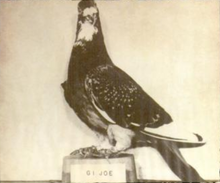G.I. Joe (pigeon)
| G.I. Joe | |
|---|---|

G.I. Joe on display
|
|
| Born | March 24, 1943 Algiers |
| Died | June 3, 1961 (aged 18) Detroit |
| Place of display | Fort Monmouth, New Jersey |
| Allegiance |
|
| Service/ |
|
| Years of service | 1943–1945 |
| Battles/wars | World War II |
| Awards | Dickin Medal |
G.I. Joe (March 24, 1943 in Algiers - June 3, 1961 in Detroit) was a pigeon noted for his service in the United States Army Pigeon Service.
During the Italian Campaign of World War II, G.I. Joe saved the lives of the inhabitants of the village of Calvi Vecchia, Italy, and of the British troops of 56th (London) Infantry Division occupying it. Air support had been requested against German positions at Calvi Vecchia on 18 October 1943, but the message that the 169th (London) Infantry Brigade had captured the village, delivered by G.I. Joe, arrived just in time to avoid the bombing. G.I. Joe flew this 20 mile distance in an impressive 20 minutes, just as the planes were preparing to take off for the target. Up to a thousand men were saved.
On 4 November 1946, G.I. Joe was presented the Dickin Medal for gallantry by Major-General Charles Keightley at the Tower on London, the citation credits him with the most outstanding flight made by a United States Army homing pigeon in World War II. G.I. Joe was the 29th and the first non-British recipient of the medal.
After World War II, he was housed at the U.S. Army's Churchill Loft at Fort Monmouth in New Jersey along with 24 other heroic pigeons. He died at the Detroit Zoological Gardens at the age of eighteen, and was mounted and displayed at the U.S. Army Communications Electronics Museum at Fort Monmouth.
...
Wikipedia
